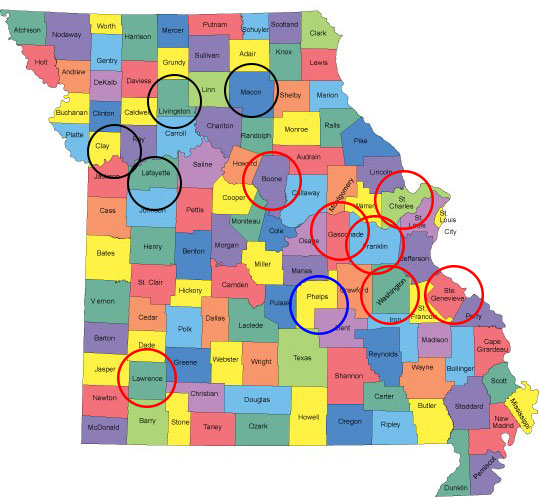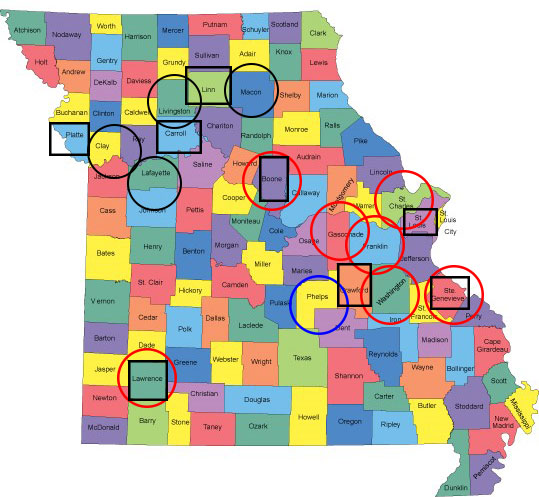Vinews
No. 3 — April 1, 2019
Contents:
Bud Mortality — Final Report
This week, grape buds were evaluated of Chardonel, Concord and Vignoles from Phelps County, Missouri. Bud mortality was 14 percent for Chardonel and 20 percent for Vignoles. Whereas, Concord had only 4 percent primary bud mortality.

Black circles represent the counties in Missouri in which grape cultivars were evaluated for bud mortality during the week of March 18, 2019. Red circles represent counties in Missouri in which grape cultivars were evaluated for bud mortality during the week of March 25, 2019. Blue circle represents the county in Missouri in which grape cultivars were evaluated for bud mortality during the week of April 1, 2019.
Why did bud mortality occur is a common question among grape growers. Bud mortality can occur almost anytime during the period from leaf fall to bud break. Once leaf fall has occurred the grape buds have attained a moderate degree of hardiness to cold temperatures. Most buds at the time after leaf fall through early December will be insensitive to temperatures in the range of 5 to 20 ºF. In Missouri there were no low temperatures recorded during this period that would have caused bud mortality. The extreme cold events occurred in the latter half of January 2019. Some areas in North-Central Missouri experienced low temperatures near -15 ºF (Table 1 and Figure 1). In most of the areas in which bud mortality was evaluated below zero temperatures were recorded for late January except for St. Genevieve and Lawrence counties.
Table 1. Low temperatures recorded for selected counties on 30 January 2019.
| County | Temperature °F 1 |
|---|---|
| Boone | -9.3 |
| Carroll | -9.8 |
| Crawford | -0.1 |
| Lawrence | 6.9 |
| Linn | -14.3 |
| Platte | -11.3 |
| Ste. Genevieve | 8.6 |
| St. Louis | -5.2 |
1 Data available at Missouri Historical Agricultural Weather Database.
Some of the grape cultivars grown in Missouri have similar bud hardiness during the period of January through February (Table 2). During this period of time the grape buds are least sensitive to cold periods. Grape buds can be tested for critical temperatures that will cause damage using differential thermal analysis. Briefly, buds are collected and removed from the cane wood. The buds are placed inside a modified freezer and the temperature is slowly lowered over time. A thermocouple is attached to the buds. When a bud freezes, a small amount of heat is released and this heat release is recorded by the thermocouple. Cornell University has multi-year temperature exotherms for some of the grape cultivars grown in Missouri. For example, for Chambourcin, 50% of the buds will freeze at -11.74 ºF (16-year average). There will be differences in bud-hardiness in Chambourcin between Missouri and New York. I would expect that Chambourcin buds from Missouri will be more sensitive to cold temperatures compared to Chambourcin buds from New York. The New York data provides some baseline data for some of the grape cultivars grown in Missouri. The data in Table 2 also suggests that Chardonel, Chanbourcin, and Vignoles would be the most sensitive to cold temperatures compared to Concord.

Figure 1. Black boxes represent counties represented in table 1.
Table 2. The temperature at which 50 percent of the buds will freeze. Buds were sampled during the period of January through mid-February and the average Bud50 is presented based on the number of years evaluated.
| Cultivar | Bud501 °F |
Years No. |
|---|---|---|
| Chambourcin | -11.74 | 16 |
| Chardonel | -10.9 | 10 |
| Valvin Muscat | -14.2 | 14 |
| Vincent | -12.2 | 2 |
| Vidal blanc | -12.5 | 6 |
| Vignoles | -11.8 | 6 |
| Catawba | -13.9 | 6 |
| Concord | -18.0 | 15 |
1 Data available from Cornell University: https://grapesandwine.cals.cornell.edu/extension/bud-hardiness-data/about/midwinter-bud-hardiness-selections-cornell-grape-breeding-program/.
There is more to grape bud cold hardiness
- Drought, disease pressure, overcropping, and delayed harvest can impact a buds ability to attain cold hardiness.
- Hanging fruit for late harvest wines or ice wines can delay cold acclimation.
- An early killing frost event near the time of harvest limits carbohydrates going to storage structures of the grapevine — roots, trunks, cordons and spurs. Again, bud hardiness can be reduced.
- Site selection can impact cold acclimation and cold air drainage. Vineyards located on mid-slope areas will have greater cold air drainage than sites located in frost pockets.
- Delaying pruning until extreme cold winter weather has passed allows one to adjust bud counts based on the level of bud mortality. January and February are the coldest months in Missouri.
Food Safety Modernization Act (FSMA) Update
On March 27, 2019, wine grapes, hops, pulse crops, and almond producers were exempted from the Food Safety Modernization Act (FSMA) Produce Safety Rule.
For more information on the FDA announcement
What does the announcement mean for wine grape producers in Missouri?
- You will not need a letter from the winery/processor stating how the grapes will be processed to kill pathogens